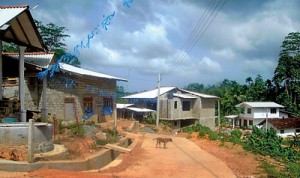Questioning the role of finance and state authorities
The draft national housing policy presented by the Government is a relatively short, under 40 pages, yet an important document. It discusses the need to diversify the housing market including promoting rental housing, expand loan facilities for low and middle income groups, and provide tax incentives for builders. The policy is available on the web at www.housingpolicy.lk as part of the National Housing Development Authority’s consultation with the public, which expired on September 30th, 2013.
In terms of its content, the policy emphasizes the need to provide for a variety of settlement types including urban, estate, and rural areas. The document identifies specific goals for each area but for the purposes of this brief assessment I will concentrate on the urban housing situation. After giving some brief context, I will discuss the role of finance in housing and the relations among state institutions implementing the proposed changes. These two themes must be addressed in order to ensure the equitable and democratic participation of the urban poor in the housing market.
To begin, the housing policy document is part of a historical shift from an approach that emphasized the government as provider (1950s-1970s) to regulator of housing (late 1970s-present). During the (Chandrika) Kumaratunga era the Real Estate Exchange Limited was created along with the increasing scope for financial activities through repeal of NHDA provisions that prevented sale of housing granted by the NHDA. These dynamics fit into the overall transition of the economy from an emphasis on manufacturing in the 1980s, to the increase in financial activities from the 1990s onward. Right to housing as a basic need is potentially affected however by the greater risks of economic crisis that these developments entail.
Financing housing
The draft document proposes new forms of loan provisioning. Several important aspects of these changes include promoting ownership of individual units within new high rise apartments along with providing loans through institutions such as the NHDA that are funded by the Central Bank. The increase in a secondary mortgage market may open up new funding options for the urban poor. At the same time there should be caution given the parallel expansion of precarious and temporary employment for urban poor and lower income residents. This trend in employment could undermine the basis for fulfilling long-term obligations to housing finance.
Moreover, the construction of housing itself relies on mechanisms of financialization such as the release of debentures by NHDA and the Urban Development Authority. This is part of the central plank to “liberate prime lands” for private development. This economic emphasis however raises questions about the viability of the overall plan to develop Colombo as an IT and financial hub in order to attract foreign and private investment. The long term growth of the service sector of the economy is implicated with housing  provision. The resulting instability as a result of capricious global trends could have negative effects on housing for the urban poor.
provision. The resulting instability as a result of capricious global trends could have negative effects on housing for the urban poor.
Housing then is implicated with the economy, including growth of the construction sector but also the potential danger of asset bubbles based on perceived trends in other sectors such as tourism. Necessary safeguards should be put into place for lower and middle income tenants as insurance against a potential economic crisis. Failing to do so could create a shock similar to the effects the subprime mortgage crisis had on the US and global economy in 2008. The crisis resulted in the massive wave of evictions that inspired popular outrage in that country.
Role of state institutions
In terms of implementing institutions, the housing policy emphasises the role of the NHDA. At the same time concurrent efforts to redevelop prime lands in Colombo are being overseen by the UDA. This informal division of labour among state institutions should be clarified, particularly since the housing policy document emphasises a strategic planning approach. How will the NHDA interact with the UDA given the draft housing policy’s emphasis on the NHDA as the key implementing institution? What are the criteria and basis for dividing up Jana Sevana, the Urban Regeneration Project, Nagamu Purawara, and other housing projects among the authorities?
In addition to national institutions, the draft housing policy emphasises grassroots level planning. It doesn’t specify the role, however, of relevant decentralised and municipal structures. What’s the role of the Colombo Municipal Council and other local institutions such as the Community Development Councils? Moreover, the document does not adequately explore the role of public consultation on mass involuntary displacement occurring in Colombo, and the potential alternative of in situ upgrading of urban poor housing. A useful contrast is the Million Housing Programme (MNP) of the 1980s and 1990s. The MHP promoted such forms of upgrading along with decentralised structures such as the Pradeshiya Mandalas and Gramodaya Mandalas. An emphasis on grassroots planning must specify the role of relevant decentralised and local government authorities in order to move beyond rhetoric.
Having touched on the two themes of mechanisms of financing along with questions about implementation through relevant government institutions, it is important to emphasise the similarities and differences between the draft national housing policy and past policies. On the one hand, the current document is a product of the times insofar as it employs World Bank-style rhetoric about cutting restrictions on land sales. On the other hand, the draft policy statement can be radicalised by connecting it to past grassroots initiatives such as the MHP. Housing policy must make a clear connection to pro-poor initiatives in order to build on the draft document’s strengths including its proposal to accommodate diverse housing needs.
(The writer is a PhD student at the University of California Los Angeles and an activist with the Collective for Economic Democratisation in
Sri Lanka)


